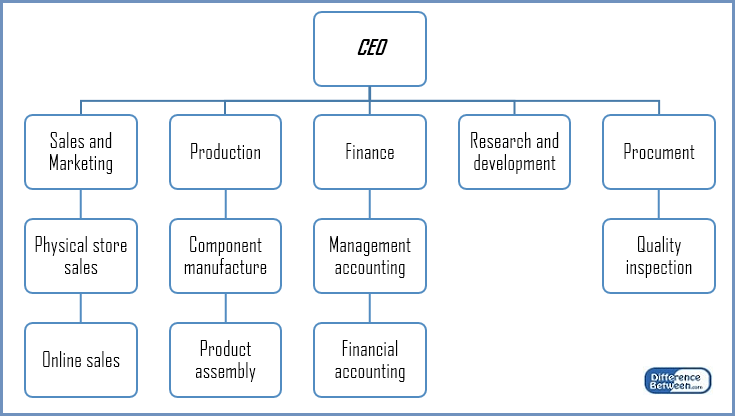Difference Between Functional and Divisional Structure
Key Difference – Functional vs Divisional Structure
The key difference between functional and divisional structure is that functional structure is an organizational structure in which the organization is divided into smaller groups based on specialized functional areas such as production, marketing and sales whereas divisional structure is a type of organizational structure where operations are grouped based on divisions or separate product categories. An organization can be arranged according to a variety of structures, which enable the organization to operate and perform. The objective of the same is to carry out operations smoothly and efficiently.
CONTENTS
1. Overview and Key Difference
2. What is Functional Structure
3. What is Divisional Structure
4. Side by Side Comparison – Functional vs Divisional Structure
5. Summary
What is Functional Structure?
A functional organization is a commonly used organizational structure in which the organization is divided into smaller groups based on specialized functional areas such as production, marketing and sales. Each function is managed by a departmental head that has a dual responsibility to be accountable to the top management and to direct the respective department to achieve favorable performance. Such functional areas are also referred to as ‘silos’.
Functional structures are ‘U-form’ (Unitary form) organizational structures where the operations are categorized based on common expertise and experience. The functions such as finance and marketing are shared across divisions or products. The most significant advantage of this type of a structure is that the company will be able to benefit from specialized functional expertise and enjoy notable cost savings by using shared services.
E.g. SDH Company operates with a divisional structure and produces 5 product categories. All these categories are produced by a SDH’s production team and marketed by a sole marketing team.
However, functional structures are difficult to adopt for larger scale companies that operate in a wide geographical area, especially if the organization has overseas operations. In the above example, assume that 2 out of the 5 product categories are sold in two different countries. In that case, the products have to be shipped to the respective countries and different marketing approaches may have to be used.

What is Divisional Structure?
Divisional structure is a type of organizational structure where operations are grouped based on divisions or separate product categories. Here, separate functions such as Production, HR, and finance can be seen under each division to support each product line. Divisional structures are also named as ‘M-form’ (Multidivisional form) and are most suitable for companies who operate with several product categories in geographically dispersed markets.
Multinational organizations such as Unilever, Nestle have expanded their businesses to cover all the regions in the world. They have production plants in a number of countries to produce and sell in respective countries. Due to the high volume of production, it is not practical to produce all products in a single location and distribute to a number of countries. For such organizations, they have limited choice but to adopt a divisional structure.
In this type of an organization structure, inefficiencies in one division do not affect the other divisions unlike in a functional structure since the divisions remain separate. Further, the divisional managers have significant autonomy to be responsive to customer demand without much influence from top management from the parent company. On the other hand, control issues are much likely to arise due to the scale of the organizations and divisional managers acting upon their own personal agendas without considering working towards a common corporate objective. Divisional structures are very costly to operate since cost benefits available to functional structures through shared services are not enjoyed. Tax implications and additional regulations are also applicable to companies that operate in multiple countries.

What is the difference between Functional Structure and Divisional Structure?
Functional Structure vs Divisional Structure | |
| Functional structure is organizational structure in which the organization is divided into smaller groups based on specialized functional areas such as production, marketing, and sales. | Divisional structure is a type of organizational structure where operations are grouped based on divisions or separate product categories. |
| Specialization | |
| High specialization can be seen in functional organizations since the use of shared functions | Divisional organizations use separate functions and this result in low specialization. |
| Autonomy for managers | |
| The majority of the decisions are taken by the top management, thus limited autonomy for managers under the functional structure. | In divisional structure, significant autonomy is granted for divisional managers. |
| Suitability | |
| Functional structure is suitable for organizations that operate in a single location with a single product category | Divisional structure is appropriate for companies that have multiple product categories and is present in a number of locations. |
Summary- Functional vs Divisional Structure
The difference between functional organization and divisional organizations mainly depends on the way they are structured. An organization that has a management structure of sharing functions is called functional organization. If the tasks are segregated according to separate divisions or product categories, such organizations are divisional organizations. The organization structure should be carefully chosen and this will depend on the nature of the business and the preference of the top management. Properly managed organizational structures can result in higher employee motivation and reduced costs.
References:
1.”Functional Structure – Boundless Open Textbook.” Boundless. Boundless, 31 May 2016. Web. 04 Apr. 2017.
2. “MSG Management Study Guide.” Line Organization. N.p., n.d. Web. 04 Apr. 2017.
3. “Divisional Structure – Boundless Open Textbook.” Boundless. Boundless, 08 Aug. 2016. Web. 04 Apr. 2017.
4. “Advantages & Disadvantages of Divisional Organizational Structure.” Chron.com. Chron.com, 03 June 2010. Web. 04 Apr. 2017.
ncG1vNJzZmivp6x7pbXFn5yrnZ6YsqOx07CcnqZemLyue8OinZ%2Bdopq7pLGMm5ytr5Wau26y1KearaGfo66tecCnm2auo2KxqsLIrKCoppGherTA0a6ara2imnw%3D